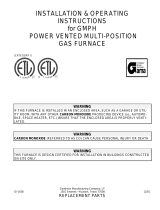
6
COMBUSTION AIR & VENTING REQUIREMENTS
WARNING:
CARBON MONOXIDE POISONING HAZARD
Failure to follow the steps outlined below for
eachapplianceconnectedtotheventingsystem
beingplacedintooperationcouldresultincarbon
monoxidepoisoningordeath.Thefollowingsteps
shallbefollowedwitheachindividualappliance
connectedtotheventingsystembeingplacedin
operation,whileallotherappliancesconnectedto
theventingsystemarenotinoperation:
1.Seal any unused openings in the venting
system.
2.Inspecttheventingsystemforpropersizeand
horizontalpitch,asrequiredintheNationalFuel
GasCode,ANSIZ223.1/NFPA54ortheCSA
B149.1,NaturalGasandPropaneInstallation
Codesandtheseinstructions.Determinethat
there is no blockage or restriction, leakage,
corrosionandotherdeciencieswhichcould
causeanunsafecondition.
3.Asfaraspractical,closeallbuildingdoorsand
windowsandalldoorsbetweenthespacein
whichtheappliance(s)connectedtotheventing
system are located and otherspacesofthe
building.
4.Closereplacedampers.
5.Turn on clothes dryers and any appliance
notconnectedtotheventingsystem.Turnon
anyexhaustfans,suchas rangehoodsand
bathroomexhausts,sotheyareoperatingat
maximum speed. Do not operate a summer
exhaustfan.
6.Follow the lighting instructions. Place the
appliance being inspected into operation.
Adjustthethermostatsoapplianceisoperating
continuously.
7.Test for spillage from draft hood equipped
appliances at the draft hood relief opening
after5minutesofmainburneroperation.Use
theameofamatchorcandle.
8.Ifimproperventingisobservedduringanyof
theabovetests,theventingsystemmustbe
correctedinaccordancewiththeNationalFuel
GasCode,ANSIZ223.1/NFPA54and/orCSA
B149.1,NaturalGasandPropaneInstallation
Codes.
9.Afterithasbeendeterminedthateachappliance
connectedtotheventingsystemproperlyvents
whentestedasoutlinedabove,returndoors,
windows,exhaustfans,replacedampersand
anyothergas-redburningappliancetotheir
previousconditionsofuse.
AVERTISSEMENT:
RISQUED’EMPOISONNEMENTAU
MONOXYDE DE CARBONED
Le non-respect des consignes suivantes portant
sur chacun des appareils raccordés au système
d’évacuation mis en service pourrait entraîner
l’empoisennement au monoxyde de carbone ou
la mort. Les consignes suivantes doivent être
observéespourchaqueappareilraccordéausystème
d’évacuationmisenservicesilesautresappareils
raccordésausystèmenesontpasenservice:
1.Scellertouteouverturenonutiliséedelasystéme
d’évacuation;
2.S’assurerquelasystémed’évacuationprésente
des dimensions et une pente horizontale
conformes à la norme ANSI Z223.1/NFPA
54, intitulée National Fuel Gas Code ou aux
codes d’installation CSA-B149.1, ainsi qu’aux
présentesinstructions.S’assurerquelasystéme
d’évacuation n’est pas bloquée, restreinte,
corrodée,qu’ellenefuitpasetqu’elleneprésente
aucunautredéfautpotentiellementdangereux;
3.Danslamesuredupossible,fermertoutesles
portesetfenêtresdubâtiment,ettouteslesportes
entrelapièceoùsetrouvel’appareilraccordéà
lasystémed’évacuationetlesautrespiècesdu
bâtiment.
4.Fermerlesregistresdesfoyers;
5.Mettre en service les sécheuses et tout autre
appareil qui n’est pas raccordé à la systéme
d’évacuation.Fairefonctionneràrégimemaximal
toutventilateurd’évacuation,telqueleshottesde
cuisinièreetlesventilateursdesallesdebains.
Nepasmettreenservicelesventilateursd’été.
6.Respecterlesinstructionsd’allumage.Mettreen
servicel’appareilàl’essai.Réglerlethermostat
demanièreàcequel’appareilfonctionnesans
interruption;
7.Vérifier s’il y a débordement à l’orifice
d’évacuationducoupetiragedesappareilsdotés
d’un coupe tirage 5 minutes après l’allumage
du brûleur principal. Utiliser la amme d’une
allumetteoud’unechandelle.
8.Si l’on constate, au cours de l’un des essais
quiprécèdent, quel’évacuationest déciente,
corrigerlesystèmed’évacuationconformément
àla normANSIZ223.1/NFPA 54, NationalFuel
GasCode,et(ou)auxcodesd’installationCSA
B149.1.
9.Après avoir déterminé que tous les appareils
raccordésàlasystémed’évacuationévacuent
correctement tel que prescrit ci-dessus,
rouvrirlesportesetlesfenêtresetremettreles
ventilateursd’évacuation,lesregistresdefoyers
ettoutautreappareilfonctionnantaugazàleur
étatdefonctionnementinitial.




















